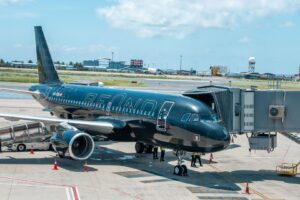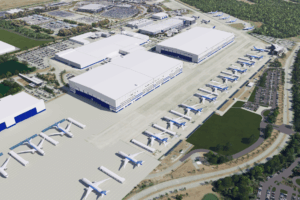
Seattle-based planemaker Boeing Aerospace (NYSE: BA) finds itself on steadier footing entering the second half of 2025. The manufacturer has achieved steady production of 38 jets per month, with plans to seek approval to increase that figure to 42 per month, which became clear during the company’s second-quarter earnings call. Analyst expectations have been upgraded for the manufacturer over the next 6-12 months, with improved production rates and an improved cash flow picture cited as principal catalysts.
The certification timeline for the smaller Boeing 737 MAX 7 and MAX 10 models, however, remains mostly uncertain, with the manufacturer again pushing the timeline back to mid-2026. Nonetheless, Boeing’s leadership team has noted that further certification delays should not impact its production ramp-up, due to the large order backlog for Boeing 737 MAX 8 and MAX 9 models. Let’s take a deeper look at Boeing’s production increases and the impact they have on the company’s outlook for the back half of 2025.
Boeing Looks To Push Boeing 737 MAX Output to 42 Jets Per Month
Photo: BlueBarronPhoto | Shutterstock
Despite years of struggles related to a pair of deadly crashes and a high-profile door plug blowout incident, Boeing’s flagship narrowbody aircraft line no longer appears to be in stop-start mode. Management has continued to reiterate its intent to boost production to beyond 42 aircraft per month before the year ends.
The biggest challenge to achieving this will obviously be regulatory approval. From the rhetoric of Boeing leaders, however, it appears that confidence is relatively high in the company’s ability to secure this issue. Aerospace regulators have yet to officially provide their view on whether they believe Boeing can increase production rates without backsliding on quality. According to the company’s earnings release, CEO Kelly Ortberg is well aware that safety is the company’s principal responsibility. In a statement, he had the following words to share:
“As we look to the second half of the year, we remain focused on restoring trust and making continued progress in our recovery while operating in a dynamic global environment.”
Airlines Can Begin Expecting Boeing to Meet Delivery Timelines
Photo: Wirestock Creators l Shutterstock
More predictable production timetables do offer numerous benefits for carriers. With Boeing beginning to steady output and improve delivery figures over the next six quarters, airlines can begin to plan schedules with greater confidence. They can also begin to retire older jets and be confident that costly short-term leases will not be needed to fill the gaps.
The MAX 7 and MAX 10 certification delays certainly add some friction into the mix here, but some customers are fully prepared to substitute these aircraft with other Boeing 737 MAX family variants (United Airlines, for example, is already thinking of replacing 737 MAX 10 orders with MAX 8 or MAX 9 models).
For airlines that are more concerned with their long-haul fleets, Boeing has also been able to incrementally improve production figures for the Boeing 787 Dreamliner and the Boeing 777. While delivery delays for these models have been more last-minute changes than months-long delays, this shift also gives many carriers peace of mind. For airlines that overwhelmingly rely on Boeing aircraft, the biggest operational supply-side risk could be beginning to subside.
What Are The Financial Implications Of These Production Increases For Boeing?
Photo: VDB Photos | Shutterstock
Carefully executing a production ramp-up during the second half of 2025 will have major financial implications for Boeing throughout 2026. Despite expecting net cash outflows throughout the second half of the year, management expects cash flows to turn positive next year.
Photo: Stock Analysis
Boeing shares have risen 31.31% since the start of the year, despite some tariff-related uncertainty leading to an early sell-off in April. Average price targets are currently around $230-250, with analysts mostly rating the stock as a strong buy.
Stock Code
BA
Business Type
Planemaker
Date Founded
July 15, 1916
CEO
Kelly Ortberg
Headquarters Location
Chicago, USA
Nonetheless, investors still have reason to be hesitant about the company’s prospects. Boeing has yet to turn a profit this year, with shares currently trading at a negative price-to-earnings multiple of around -14. According to Stock Analysis, some investors are still betting against the company, with around 2.27% of shares currently sold short.






